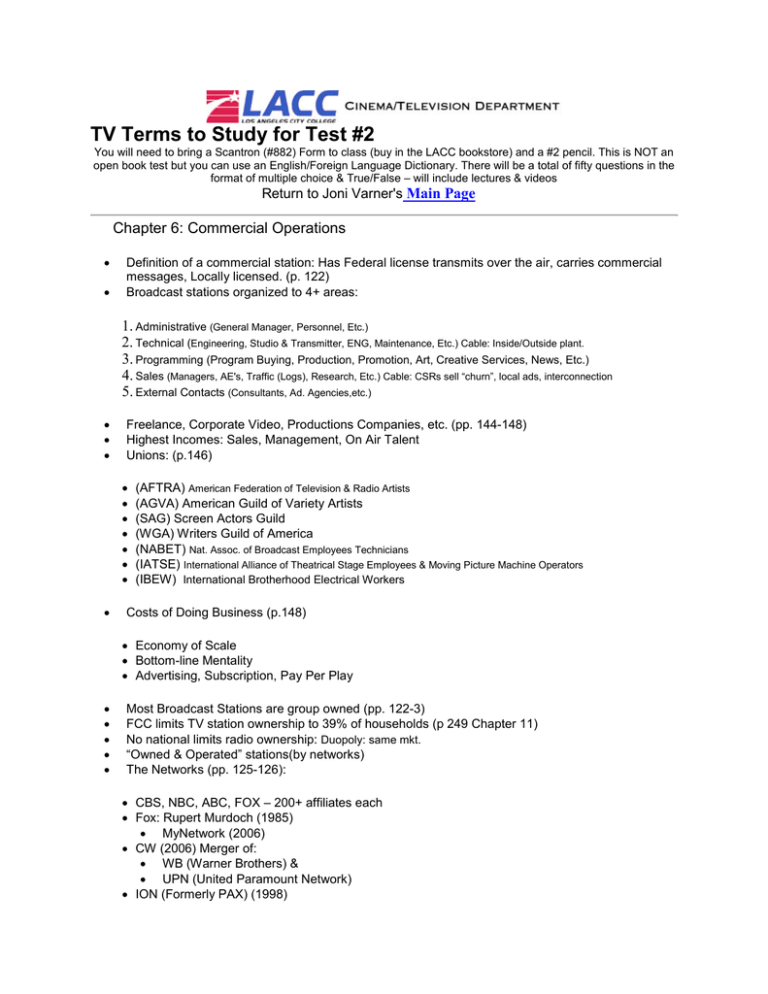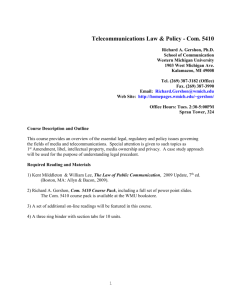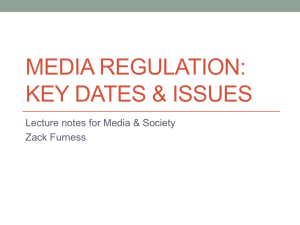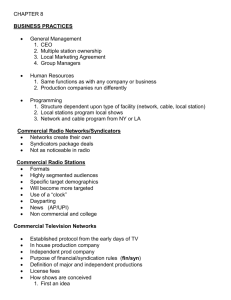TV Terms to Study for Test #2
advertisement

TV Terms to Study for Test #2 You will need to bring a Scantron (#882) Form to class (buy in the LACC bookstore) and a #2 pencil. This is NOT an open book test but you can use an English/Foreign Language Dictionary. There will be a total of fifty questions in the format of multiple choice & True/False – will include lectures & videos Return to Joni Varner's Main Page Chapter 6: Commercial Operations • • Definition of a commercial station: Has Federal license transmits over the air, carries commercial messages, Locally licensed. (p. 122) Broadcast stations organized to 4+ areas: 1. Administrative (General Manager, Personnel, Etc.) 2. Technical (Engineering, Studio & Transmitter, ENG, Maintenance, Etc.) Cable: Inside/Outside plant. 3. Programming (Program Buying, Production, Promotion, Art, Creative Services, News, Etc.) 4. Sales (Managers, AE's, Traffic (Logs), Research, Etc.) Cable: CSRs sell “churn”, local ads, interconnection 5. External Contacts (Consultants, Ad. Agencies,etc.) • • • Freelance, Corporate Video, Productions Companies, etc. (pp. 144-148) Highest Incomes: Sales, Management, On Air Talent Unions: (p.146) • • • • • • • • (AFTRA) American Federation of Television & Radio Artists (AGVA) American Guild of Variety Artists (SAG) Screen Actors Guild (WGA) Writers Guild of America (NABET) Nat. Assoc. of Broadcast Employees Technicians (IATSE) International Alliance of Theatrical Stage Employees & Moving Picture Machine Operators (IBEW) International Brotherhood Electrical Workers Costs of Doing Business (p.148) • Economy of Scale • Bottom-line Mentality • Advertising, Subscription, Pay Per Play • • • • • Most Broadcast Stations are group owned (pp. 122-3) FCC limits TV station ownership to 39% of households (p 249 Chapter 11) No national limits radio ownership: Duopoly: same mkt. “Owned & Operated” stations(by networks) The Networks (pp. 125-126): • CBS, NBC, ABC, FOX – 200+ affiliates each • Fox: Rupert Murdoch (1985) • MyNetwork (2006) • CW (2006) Merger of: • WB (Warner Brothers) & • UPN (United Paramount Network) • ION (Formerly PAX) (1998) • Univision & Telemundo (+ Over 100 smaller networks) • • • • • • • • • Independent TV (Not affiliated with a network) Affiliate: network contract for exclusive broadcast rights in exchange for clearing programming time (pp. 126127) Clearance: affiliate’s contractual agreement to clear in its program schedule the times the network needs to run its programs. (Accept over 90%) Primary affiliate: the only affiliate of a network Secondary affiliate: affiliation with more than one net Network Comp: cash compensation for the right to use a station’s time to insert local coml. Adjacencies Reverse Compensation: stations PAY networks Multicasting: Nets negotiating with affiliates to use SDTV subchannels as vehicles for new secondary programming Cable Television (pp. 129-133): • Revenue from subscribers, internet, leased channels • (MSOs) Multiple System Operators (Top 25 = 90%) • Telephone companies can own cable since 1990s • Vertical Integration of Entertainment Companies: • Time Warner, Disney/ABC, NBC/Universal • Fox/News Corp, CBS/Viacom • Cable TV Networks Categories (pp. 132-3, 143-4): • • • • • • • • • Basic Service Tier (PEG) Expanded Basic/Digital Tier (per subscriber fee) Superstations (local broadcast stations on satellite) Pay-Cable or Premium Networks (extra fee) PPV (Pay Per View) VOD (Video On Demand) SYNDEX (Syndication Exclusivity) - deletes programs that conflict with local stations TV broadcasting largest national ad medium, Radio=4th Advertising: three broad categories (pp. 133, 135) • 1) Local , 2) National Spot (Regional), 3) Network • CO-OP(Cooperative Advertising) shares costs between local merchant & national manufacturer • Yield Management: Drives Ad Prices • Advantages to Broadcast Advertising: • • • • • • All homes have radio & TV receivers Audiences can be targeted by the time of day TV demonstrates how the product looks & works One station can carry local or national ads Network ads have prestige and nation-wide appeal Preemptibiltiy: Less expensive if “make goods” • Disadvantages to broadcast advertising: • • • • • • • • • Large geographical coverage, Cable more local Limited inventory (only 24 hrs/day) Zapping = 20% less audience ads Limited amount of ad length - radio=:60, TV=:30 No cigarette ads after 1971 (Congress) No hard liquor ads (1996), Casinos (1999) Ad Agencies: purchase & create ads, media mix (p141) Product Placement (Characters Use Products) Local Sales (AE=Account Executives), (p 135-6) • Cold calls, commission, audience research • • National Sales Representative Firms or “Reps” sell national advertising for local stations GRPs (Gross Rating Points) TRP (Target RP) (p138) • Price Depends on: Market size, affiliation, popularity, time of day, Spot Position (break) Preemptibility, bulk • • (CPM) Cost Per Thousand (p138) compares media costs Web Advertising (pp. 140-1): • • • • • • • Broadcast Advertising (pp. 136-7, 139): • • • • • • • • • • • • All the top 100 national advertisers use (1999) Not limited by time or geography (real time) Banner Ads lead to Click Through Viral Marketing: person to person Mobile Phones (outnumber other media 4 to 1) Mobile Banner (top) & Mobile Poster (bottom) Trade-Outs or Deal = pay airtime with goods not $ Barter Deals = exchange ad time for programs Time Brokerage-buys ad time in blocks, resells (PI) or Per-Inquiry ads - pay only for responses (ROS) “Run of the Schedule” ad aired any time of day Traffic schedules Non-Competing Ads Station Identification (IDs) required by law Promotional Announcements (Promos) station itself Public Service Announcement (PSA) non-profit orgs. Proof of Performance (logging) Avails (Upfronts) Advertising Standards (p 141-2): • • • • • Communications Act /1934: Sponsor Identification Rule FCC has a “hands-off” policy for regulating advertising (FTC) Federal Trade Commission investigates ads FCC NEVER set a maximum limit of ads per hour NAB (National Association of Broadcasters) suggested number of commercials: anti-trust • Action for Children’s TV/law limits ads kids shows • FCC banned infomercials until (1981 Radio &1984 TV) Chapter 7: Noncommercial Services (pp. 151-165) • • • • • • • • • • • • 1920s - first educational broadcasting stations 1945 - FCC allocates 20 FM channels for educational 1952 - FCC “6th Report & Order”: Education channels 1967 – Report by Carnegie Commission – “Public TV” 1992 - DBS must give 4-7%+ channels non-coml. (p160) 1967 - Public Broadcasting Act - creates: CPB (Corporation for Public Broadcasting) funding 1970 - Public Broadcasting Service (PBS) satellite PBS Syndication Services (replaces SPC) programs 1970 - NPR (National Public Radio) links+programs (p163) 1983 - PRI (Public Radio International) (formerly APR) PBS Delivery: satellite, iTunesU, Hulu, multicasting, PBS World, DirecTV, PBS.org, Cable in the Classroom, etc. (pp. 155-6, 159) Sources of Income (p.157): Foundations, Corporate Underwriting, Public Contributions, Enhanced Underwriting, Merchandise, etc. Chapter 8:Programs & Programming Basics • Parsimony Principle: (sparingly, repeated, shared) • • • • • 80/20 Principle: small number of large media firms control the bulk of advertising dollars (pp. 168-9) • • • • • • • Syndication (Reruns) Targeting - Segmentation (p 167) Ratings Points are commodities Looking for Profit Margin (reality shows) Big Four Networks Control 50% of all TV 70-80% of cable viewing among 20% channels Zero Sum Market: total number of customers remains unchanged (zero) steal from competition Long Tail: Products with low sales can collectively make up a market share (Internet, e-publishing, downloads = little distribution cost) PrimeTime (8-11PM EST/PST) (7-10 CST/MST) 22 hrs. DAYPARTS: blocks of time in which several or one consistent type of program may be offered. Similar costs. Radio Dayparts (p 171): Morning Drive: 6am – 10am Midday: 10am – 3pm Afternoon Drive: 3pm – 7pm Night: 7pm – midnight Overnight: midnight – 6am • Television Dayparts (p 171) : Early Morning: 6am – 9am Morning: 9am – 11am Noon: noon - 1pm Afternoon: 1pm – 4pm Early Fringe: 4pm – 6pm News Block: 6pm – 7pm Access: 7pm – 8pm Prime Time: 8pm – 11pm Late Fringe: 11pm – midnight Late Night: 1am - 2am Overnight: midnight – 6am • Stripping: same programs at the same time everyday • Checkerboard (once per week) • • • • • • • • • • • • • • • Audience Flow / Flow Through - movement of viewers between programs (p 172) Counter programming: opposite of competition Block programming: similar types of programs Strong lead-ins & outs: begin daypart strong show Hot Switching: ad - free transitions between shows Hammock: a new show between two stronger ones Tent Pole: most popular in middle of schedule Bridging: overlapping start of a competing program Repetition: same program in different time slots Stunting: short term program changes during ratings Promotion is important to viewership (LOP) Least Objectionable Program: no matter what, viewers will watch in time period Appointment TV: successful programs may be scheduled anywhere fans will follow Extended Viewing Period: allows sponsors additional media opportunities to sell, internet, etc. Prime Time Programs (p 173-4): • • • • • • • Entertainment and Information, Infotainment Scripted vs. Unscripted (semi scripted = game) Live vs. Recorded (News, Sports) Distribution Sources: Network, Syndicated, Local Programming: Studios, Indie Producers, Cable Net Local Programs: (less than 10% broadcast TV) • Cable: LO (local origination) and Public Access • TV: NEWS ($$ - up to 50% of sales) The FCC defines a syndicated TV program: (p 174) • “Any program sold, licensed, distributed, or offered to television stations in more than one market within the United States for non-interconnected (that is, non-network,) television broadcast exhibition, but not including live presentations.” • Types Of Syndication(p 175-7): • • • • • OFF-NETWORK: 1st broadcast & re-licensed local FIN/SYN (Financial Interest Syndication) (Before 1993) networks couldn’t own/produce FIRST RUN/Made-for-Syndication: never on nets PACKAGE SYNDICATION: collections in a genre CABLE SYNDICATION: movement of programs from broadcast to cable networks. + Group Deals • Syndicator licenses for $ limited number of plays • Renewal Agreement (pp. 175-6) • After license period is over syndicator resells • CASH-BARTER SYNDICATION: Instead of cash - the station may allow some of the commercial time to be pre-sold by the syndicator (reducing price) • Upgrading and downgrading: cost varies • Ratings Thresholds - fees up or down, ratings • Radio (pp. 177-8, 184): • • • • • Internet Programming: (pp 178-9) • • • • • • • Audio & Video Streaming: (Real time broadcasts) Podcasting: distributing files for playback & mobile Blogcast: a combination of a blog and podcast Webisodes: short episodes which air on Internet UGC (User Generated Content) Web material supplements Prime Time (pp 180-6) • • • • • • • News, Talk & Sports Music Networks (formats): Spanish Automation:Full Live/ Live Assist /Full Auto. Syndication: Feature Genres (content) Formats (organization) Scheduling (time of day) Deficit Financing: New programs on Nets ask producer to share in financial risk for one season Spin-offs and Clones (from successful shows) Types: Sit-coms, dramas, movies, mini series, music & variety, Reality Non Prime Time (p 186-9, 192-3) • Soap operas, Game, Magazine, Talk (network & syndicated), Home Shopping, Sports (net & cable), children’s shows, news & public affairs, docs • Promos: spots promoting one’s own programming • Generic, Specific/episodic (p 195) • Broadcasting targets women age 18 – 34 (49) • Advertisers are interested other facts (p 138): • DEMOGRAPHICS (age & gender) • PSYCHOGRAPHICS (lifestyle & interests) • • 1961(NAB) FCC Chairman Newton Minow = vast wasteland 1980s-FCC Chairman Mark Fowler = toaster with pictures




